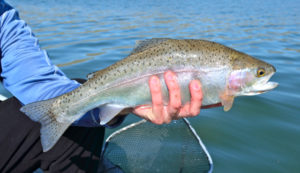Seems like “slow” best describes overall action on regional still waters this summer, and that makes the reason for so few reports from us. Few visits we have heard of to Chesterfield, Hawkins, Treasureton and Twenty-Four Mile have been very productive (try leech patterns at depth). Likewise, best action at Sand Creek Ponds seems to be during early AM hours (try soft hackle patterns just below the surface). That’s not surprising when reports of mid day water temperatures being as high as in the low 70s degrees F. are frequent here. Springfield Reservoir has been slow except for those who know where springs enter or are submerged. Cooler water here acts as a comfort haven, especially for larger fish so dependent on dissolved oxygen content. Daniels Reservoir produces depending on who offers a report. Seems like presenting midge pupa patterns under an indicator works after the taking depth is found.
Consider trying still waters at higher elevations where cooler air predominates. Aldous Lake is a good candidate if you do not mind walking a mile and a quarter mostly uphill while carrying a flotation device with waders and fins. Cutts in this small lake responding to speckled dun and damsel fly activity or taking small leech patterns could make it worth the effort. Lower Palisades Lake is a four mile walk from the trail head with best fishing (try leech patterns) where the inlet enters at the northeast corner. Don’t want to walk that far, you say? Horseshoe Lake is at about 6000 feet elevation and can be reached off the Cave Falls Road by a gravel road good enough with care for passage by a sedan. The reward is the only roadside grayling population in this part of Idaho. As soon as speckled duns begin emerging, these fish, along with resident rainbows, become active and respond not only to soft hackle patterns just below the surface, but to any dry pattern resembling one of these insects. True, a bragging fish here is about a foot long, but their beauty makes up for size. So use that light weight tackle to best enjoy them.
In any case, cooler weather will arrive as September advances, and the resulting effects on most still waters will bring back the action we have been waiting for.




